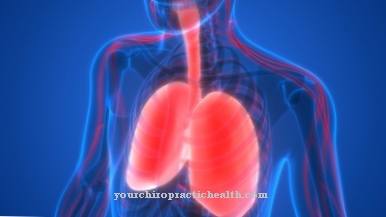As Residual volume is the term used to describe the amount of air that can be exhaled as Residual air remains in the lungs and airways. It maintains the internal pressure of the alveoli and prevents them from collapsing and irreversibly sticking together. In addition, the residual air allows a continuity of gas exchange during the breathing pause between exhalation and inhalation.
What is the residual volume?

The residual volume of the lungs corresponds to the amount of air that remains in the lungs and the airways despite maximum voluntary exhalation. Maximum exhalation means that the expiratory reserve volume, which normally remains in the lungs in addition to the residual volume after exhalation, is also exhaled.
In healthy people of average height, the residual volume is around 1.3 liters and is independent of physical fitness. The total capacity of the lungs corresponds to the sum of vital capacity and residual volume. The vital capacity, in turn, is made up of the sum of the tidal volume and the inspiratory and expiratory reserve volume.
In addition to the residual volume, all other lung volumes can be measured directly spirometrically using a "small" lung function test. The residual volume can only be determined using a body or whole-body plethysmography. The plethysmograph consists of a closed, glassed-in cabin that is somewhat reminiscent of a telephone booth. The cabin is a closed gas-tight system. The increase in volume of the patient's chest (when inhaling via a spirometer, which is in contact with the air outside the cabin) leads to a minimal increase in pressure in the cabin, which is registered and used for evaluation .
Function & task
The residual air, which remains in the lungs even after maximum exhalation, fulfills two important functions. The tiny alveoli, with a variable diameter of 50 to 250 µm depending on the degree of unfolding or filling, are lined with a very fine epithelium and have a total surface of around 50 to 100 square meters. If all of the air escapes from the alveoli, there is a risk that the epithelia of the opposite alveolar walls will irreversibly stick to one another due to adhesive forces. Even breathing in again would not be able to reverse this condition. Thus, the air of the residual volume is essential for survival, as it protects the alveoli from sticking together after exhalation.
The residual volume, in conjunction with the expiratory reserve volume, fulfills another important task: The two residual air volumes, which are collectively referred to as the functional residual volume, ensure that the oxygen and carbon dioxide partial pressures are buffered. This means that the gas exchange through the membranes of the alveoli, which is controlled by the partial pressure gradient between the air in the alveoli and that of the capillaries on the alveoli, is almost continuous. The functional residual air volume ensures that the partial pressures remain as constant as possible. This function is of particular importance because the breathing and pulse rates are not synchronized.
If no residual air remained in the lungs after exhaling, this would be tantamount to discontinuous oxygen and carbon dioxide partial pressure with the consequence that the exchange of substances between blood and alveoli would also be discontinuous and would even be reversed twice.
An incorrectly coordinated heart and respiratory rate would exacerbate the problem, since in the worst case the blood in the alveolar capillaries would not come into contact with the freshly inhaled air for several breaths. The fluctuating concentration of the gases dissolved in the blood which then results would make it obsolete to control breathing using the carbon dioxide concentration in the blood as the main control parameter.
The physiological size of the lungs is independent of physical activity. It is a genetically fixed variable which, when fully utilized, determines the maximum attainable respiratory volume. The variables that can be influenced by athletic training are all volumes that are part of the vital capacity and that can increase the effectiveness of the physiologically determined lung size through good breathing technique.
You can find your medication here
➔ Medication for shortness of breath and lung problemsIllnesses & ailments
Various diseases can include restrictive or obstructive ventilation disorders or the functional failure of lung areas, have an influence on the size of the residual volume and can be used as an indicator for diagnoses or differential diagnoses.
Ventilation disorders are an expression of the underlying causative illness. Chronic obstructive pulmonary disease (COPD) in particular, which can be caused by various factors, is relatively common and is one of the top 10 causes of death worldwide. Regardless of its cause, COPD leads to an increase in the residual volume and also in the functional residual capacity. Some lung diseases ultimately lead to pulmonary emphysema, a mostly irreversible, functional failure of parts of the lungs.
A reversible disruption of gas exchange in the lungs can be caused by pulmonary edema, i.e. by deposits of tissue fluid in the alveoli.
The development of emphysema in the lungs, in particular, can have very different causes, but is usually associated with long-term inhalation of pollutants in the form of dust particles or aerosols. Your own protective system in the form of macrophages, which absorb dust particles and transport them away, can be overwhelmed by excessive stress.
Another cause of pulmonary emphysema can be a genetic defect that manifests itself as an alpha-1 antitrypsin deficiency. The enzyme normally prevents the body's own proteases from attacking the proteins in the alveolar membrane. If there is a deficiency in the protease, the membranes can become perforated, so that many alveoli can close together to form emphysema bubbles, losing their function. What all emphysema has in common is that they are associated with a characteristic increase in the residual volume.














.jpg)













